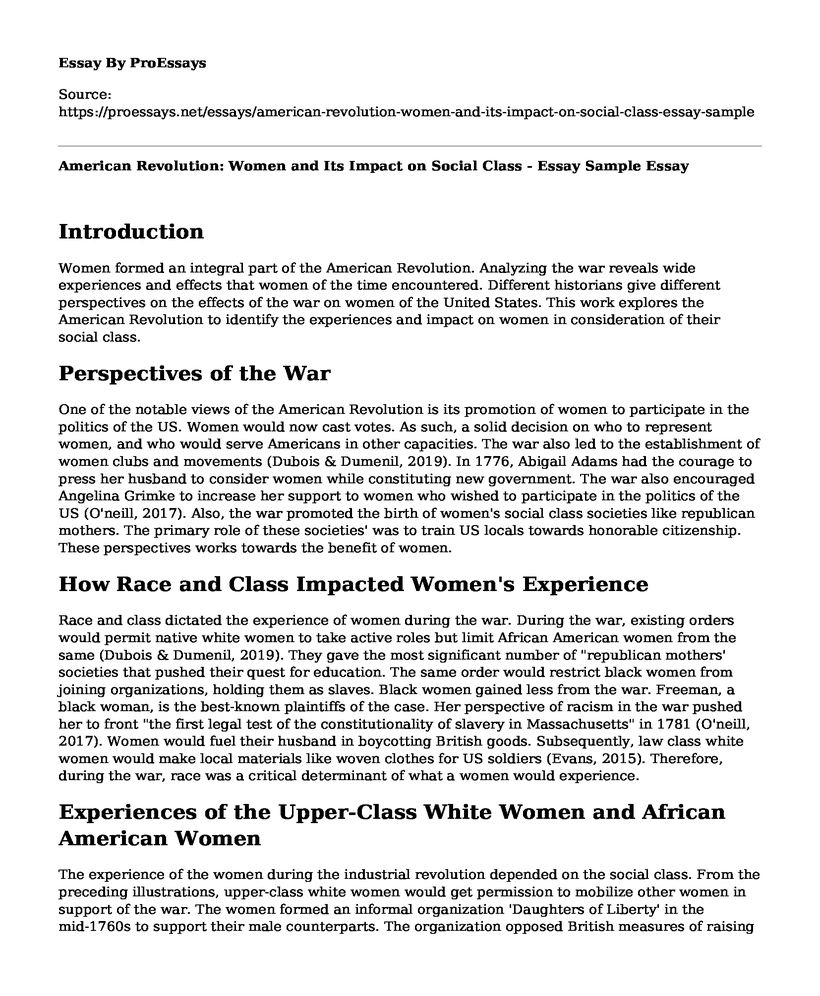Introduction
Women formed an integral part of the American Revolution. Analyzing the war reveals wide experiences and effects that women of the time encountered. Different historians give different perspectives on the effects of the war on women of the United States. This work explores the American Revolution to identify the experiences and impact on women in consideration of their social class.
Perspectives of the War
One of the notable views of the American Revolution is its promotion of women to participate in the politics of the US. Women would now cast votes. As such, a solid decision on who to represent women, and who would serve Americans in other capacities. The war also led to the establishment of women clubs and movements (Dubois & Dumenil, 2019). In 1776, Abigail Adams had the courage to press her husband to consider women while constituting new government. The war also encouraged Angelina Grimke to increase her support to women who wished to participate in the politics of the US (O'neill, 2017). Also, the war promoted the birth of women's social class societies like republican mothers. The primary role of these societies' was to train US locals towards honorable citizenship. These perspectives works towards the benefit of women.
How Race and Class Impacted Women's Experience
Race and class dictated the experience of women during the war. During the war, existing orders would permit native white women to take active roles but limit African American women from the same (Dubois & Dumenil, 2019). They gave the most significant number of "republican mothers' societies that pushed their quest for education. The same order would restrict black women from joining organizations, holding them as slaves. Black women gained less from the war. Freeman, a black woman, is the best-known plaintiffs of the case. Her perspective of racism in the war pushed her to front "the first legal test of the constitutionality of slavery in Massachusetts" in 1781 (O'neill, 2017). Women would fuel their husband in boycotting British goods. Subsequently, law class white women would make local materials like woven clothes for US soldiers (Evans, 2015). Therefore, during the war, race was a critical determinant of what a women would experience.
Experiences of the Upper-Class White Women and African American Women
The experience of the women during the industrial revolution depended on the social class. From the preceding illustrations, upper-class white women would get permission to mobilize other women in support of the war. The women formed an informal organization 'Daughters of Liberty' in the mid-1760s to support their male counterparts. The organization opposed British measures of raising revenue from Americans (Evans, 2015). Also, the wife to th Philadelphia's Governor, Esther Reed, formed the 'Ladies Association' that organized fundraising drives. The drives provided the Continental Army with the needed supplies. African-American women would remain indoors, enslaved to the whites and only play spy of the British during the war (O'neill, 2017).
Contributions of the War on the Quality of Women's' Life
The effects of the war improved the lives of women. Before the war, American women would not participate in political activities. After the revolution, under the leadership of women like Mercy Otis Warren, women were allowed to join the political arena as public figures (Evans, 2015). Feminist movements led to the improvement of women's' education. Judith Sargent Murray's essay 'On the Equality of the Sexes' (1779) also supported women in culture while Benjamin Rush work "Thoughts Upon Female Education," and her agitation for gender equality led to equal inheritance for both genders became the rule (O'neill, 2017). These contributions improved the quality of women's life.
Conclusion
American Revolution led to varying experiences on the lives of US women. These experiences depend on one's social class. Upper-class white women wore exposed to different conditions from those of African American women. However, the war led to the general improvement of the lives of US women, participating in voting, accessing education, and taking political posts.
References
Dubois, E. C. & Dumenil, L. (2019). Through Women's Eyes: An American History with Documents (Fifth edition). Boston, MA: Bedford/St. Martins.
Evans, S. M. (2015). Women's Liberation: Seeing the Revolution. Feminist Studies, 41(1), 138-149. Retrieved from https://www.jstor.org/stable/10.15767/feministstudies.41.1.138
O'neill, W. L. (2017). Feminism in America: A history. Routledge. Retrieved from https://content.taylorfrancis.com/books/download?dac=C2017-0-50998-6&isbn=9781351519977&format=googlePreviewPdf
Cite this page
American Revolution: Women and Its Impact on Social Class - Essay Sample. (2023, Mar 20). Retrieved from https://proessays.net/essays/american-revolution-women-and-its-impact-on-social-class-essay-sample
If you are the original author of this essay and no longer wish to have it published on the ProEssays website, please click below to request its removal:
- Cruelty-Free Alternatives to Leather Essay
- Research Paper on Social Entrepreneurship
- Contemporary Conversations on Immigration in the United States Paper Example
- Are Parents to Blame for Childhood Obesity Essay Example
- Essay Sample on Terrorism Laws and Counter-Terrorism Measures in the UK and Europe
- Analytical Essay Sample on Prostitution
- Essay Example on Popular Heroes or Social Menace? Serial Killers in Media







